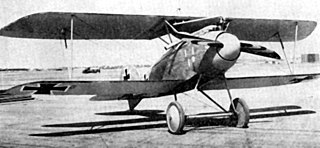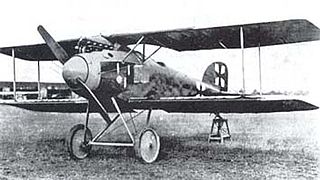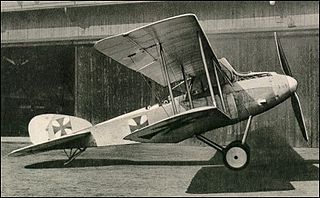
The Fokker D.VII was a German World War I fighter aircraft designed by Reinhold Platz of the Fokker-Flugzeugwerke. Germany produced around 3,300 D.VII aircraft in the second half of 1918. In service with the Luftstreitkräfte, the D.VII quickly proved itself to be a formidable aircraft. The Armistice ending the war specifically required, as the fourth clause of the "Clauses Relating to the Western Front", that Germany was required to surrender all D.VIIs to the Allies. Surviving aircraft saw much service with many countries in the years after World War I.
Albatros Flugzeugwerke GmbH was a German aircraft manufacturer best known for supplying the German airforces during World War I.

The Aero L-39 Albatros is a high-performance jet trainer developed in Czechoslovakia by Aero Vodochody. It was designed during the 1960s as a replacement for the Aero L-29 Delfín as a principal training aircraft. It was the first trainer aircraft to be equipped with a turbofan powerplant. The type was exported to a wide range of countries as a military trainer.

The Albatros C.III was a German two-seat general-purpose biplane of World War I, built by Albatros Flugzeugwerke. The C.III was a refined version of the successful Albatros C.I and was eventually produced in greater numbers than any other C-type Albatros.

The Albatros C.I,, was the first of the successful C-series of two-seat general-purpose biplanes built by Albatros Flugzeugwerke during World War I. Based on the unarmed Albatros B.II, the C.I reversed the pilot and observer seating so that the observer occupied the rear cockpit which was fitted with a ring-mounted 7.92 mm (0.312 in) Parabellum MG14 machine gun.

The Albatros B.II, was an unarmed German two-seat reconnaissance biplane of the First World War.

The Albatros D.III was a biplane fighter aircraft used by the Imperial German Army Air Service (Luftstreitkräfte) during World War I. A modified licence model was built by Oeffag for the Austro-Hungarian Air Service (Luftfahrtruppen). The D.III was flown by many top German aces, including Wilhelm Frankl, Erich Löwenhardt, Manfred von Richthofen, Karl Emil Schäfer, Ernst Udet, and Kurt Wolff, and Austro-Hungarian ones, like Godwin von Brumowski. It was the preeminent fighter during the period of German aerial dominance known as "Bloody April" 1917.

MS Albatros was a Royal Viking Star-class cruise ship, operated by the Germany-based travel agency Phoenix Reisen. She was built in 1973 by Wärtsilä Helsinki Shipyard, Finland for Royal Viking Line as Royal Viking Sea, and has also sailed under the names Royal Odyssey, Norwegian Star, and Crown. She was the second Albatros for Phoenix Reisen as she was the replacement of the original SS Albatros. MS Albatros was also known for her Queen Elizabeth 2-esque funnel. In October 2020 Albatros was sold as a hotel vessel for the Pick Albatros Group in the Middle East, which operates some 15 hotels and resorts in Hurghada region. However, the project was never initiated, and the ship stayed at Hurghada until sold in 2021 for scrap, after a stop in Jeddah. She was beached in Alang on July 27th 2021. Scrapping on Albatros started on 17th November 2021.

The Albatros D.II was a German fighter aircraft used during World War I. After a successful combat career in the early Jagdstaffeln, it was gradually superseded by the Albatros D.III.

The Albatros D.V was a fighter aircraft built by the Albatros Flugzeugwerke and used by the Luftstreitkräfte during World War I. The D.V was the final development of the Albatros D.I family and the last Albatros fighter to see operational service. Despite its well-known shortcomings and general obsolescence, approximately 900 D.V and 1,612 D.Va aircraft were built before production halted in April 1918. The D.Va continued in operational service until the end of the war.

The Albatros C.V was a German military reconnaissance aircraft which saw service during World War I.

The Albatros C.XII was a German military reconnaissance aircraft which saw service during World War I. It differed markedly from previous Albatros C-type aircraft by adopting an elliptical-section fuselage similar to that of the Albatros D.V. The C.XII also featured a tailplane of reduced area, but it retained the wings of the earlier Albatros C.X.

Albatros is a sailing ketch built in the Netherlands in 1899. Trading as a cargo sailing ship until 1996, she is now used as a training vessel.

Barbara Nesvadbová, born Barbara Nesvadbová, is a Czech writer and journalist.

Albatros was a submarine chaser of the Regia Marina built in 1930s which served during World War II. Later she was reclassified as a torpedo boat, most likely purely for administrative purposes.
The Albatros L 103 / Albatros Al 103 was a German experimental aircraft of the 1930s. It was a parasol-wing landplane of conventional configuration, seating the pilot and flight test observer in separate, open cockpits. The Al 103 was used to test variations in sweepback, dihedral and tailplane area.

Albatros was the fourth of six Type 23 torpedo boats built for the German Navy. Completed in 1927, Albatros often served as a flagship of torpedo boat units. The ship made multiple non-intervention patrols during the Spanish Civil War in the late 1930s. After an attack by aircraft of the Spanish Republican Air Force killed German sailors in 1937, she participated in the retaliatory bombardment of Almería.














